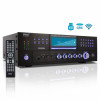Pyle PD3000BA Instruction Manual - Page 24
Special Function Playback
 |
View all Pyle PD3000BA manuals
Add to My Manuals
Save this manual to your list of manuals |
Page 24 highlights
By MPEG-4 technology, we can encode and compress a DVD lm into one or two CD-R disc with pretty good picture quality, or can burn several lms that has same quality as VCD into one CD-R disc, or burn several lms that has similar quality to DVD into DVD-ROM disc. Note: 1. The MPEG-4 discs available in the market now have many di erent formats, such as Xvid, AVI, RM etc. But some discs with "MPEG-4" logo in market are not encoded by MPEG technology. It is normal that some of the disc cannot function properly in this player because of the incorrect encoding standard. 2. The MPEG-4 les are displayed as a list in the screen, choose the icon using the cursors and press "ENTER/PLAY' button to playback the movie. 3. As AVI is the MPEG-4 format, and MPEG is MPEG-1 format, please do not combine AVI and MP3/JPEG together into a disc. The player will only recognise MP3 or JPEG in that instance. However MP3 and JPEG can be included into one disc together. SPECIAL FUNCTION PLAYBACK Kodak Picture CD Playback Playback (Normal) When a Kodak Picture CD is inserted into the unit, an automatic slide show is launched. Each picture in the Kodak Picture CD will be displayed consecutively in a slide-show fashion and will be scaled to t in the whole TV screen. Some slide-show transition modes are provided, use "PROG" key to select. You can set transition e ects for each picture. To display an image inde nitely, press the "PAUSE" key. To view the next or previous picture, press "NEXT" or "PREV" key. To resume the slide show, press the "ENTER/PLAY" key. Image Rotation There are four modes to rotate a picture: "Invert", "Mirror", Left", and "Right". These operations are allowed only when a picture is being displayed normally and will be cancelled automatically when a new picture is displayed. The arrow key is used to select the di erent rotation modes: 23 www.PyleUSA.com















